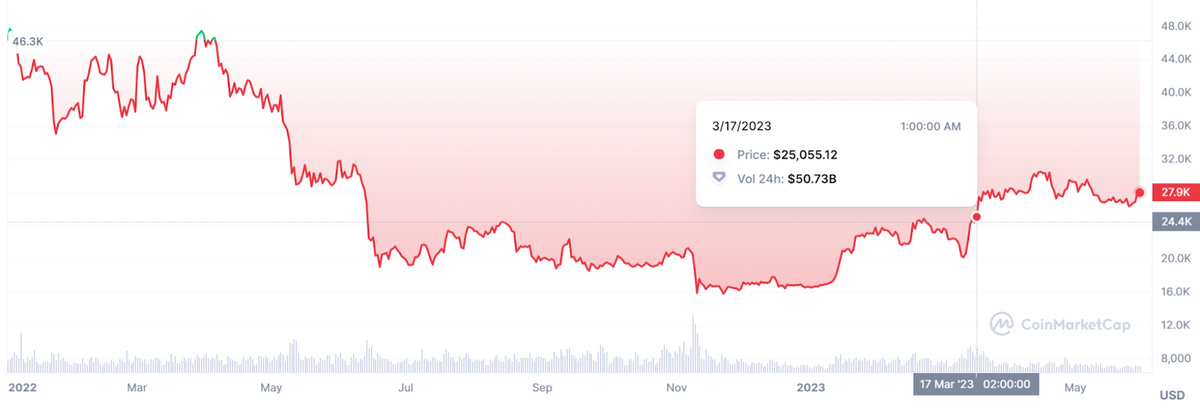
- Katarzyna Wabik highlights the key focus points for Binance in Europe.
- Europe is a diverse crypto landscape; can it be unified?
- Crypto adoption is missing a key catalyst.
Hope and fear have been major themes so far in 2023, as the crypto industry experienced highs and lows of equal intensity. The heightened concerns around the future of innovation caused by the United States’ recent regulatory crackdown set a bleak scene. But relief was soon found as major cryptocurrencies recovered to levels unseen since May 2022.
Centralized exchanges (CEX), in their role as facilitators for crypto access, felt both effects. When I attended Next Block Expo 2023 in Warsaw as DailyCoin’s Sections Editor, I caught up with Katarzyna Wabik, Binance’s Country Manager for Poland, to discuss the exchange’s sentiments.
Cutting Red Lines and Red Tape
Fears in the crypto community initially escalated when the United States Securities and Exchange Commission (SEC) targeted Kraken’s staking services in February 2023. The regulatory action generated animated discussion in the community, with Coinbase and Ripple asserting the potential harm to U.S. innovation in the space.
Sponsored
Undeterred, the industry rallied shortly after, pushing Bitcoin past the $25k mark on March 17th. The event saw CEX trading volumes soar. Market leader Binance capitalized on the event, achieving trade volume growth of $356B from Q4 2022 to Q1 2023, according to CoinGecko. Though Bitcoin’s push to $30k has yet to yield the same results, Binance is setting its sights on further growth.

In my interview with Katarzyna Wabik, we spoke about Binance in Europe, how the exchange is looking to push adoption, and its future initiatives.
Binance and Europe: The Key to Adoption?
To date, Binance has acquired registration in seven European countries, with Sweden becoming the latest in January 2023. Following the formal approval of MiCA on April 20th, which stands in stark contrast to the approach seen in the U.S., all eyes are now on Europe. I decided to dig into how Binance views the opportunities in the vast jurisdiction.
Sponsored
What can you tell me about Binance’s vision for crypto adoption in Europe?
“We would like to focus on building products that are easy to use for people because we truly believe that crypto should be a democratic thing, easily accessible for everyone. So we believe that when it comes to adoption, the user experience, and all these exchanges and crypto products should be easy to use for people of different ages, for example.
We also believe that MiCA regulations will help with adoption because it will be more compliant across the world to Europe, especially in terms of using crypto. So adoption should grow with the regulation and the implementation of MiCA.“
There is quite a difference between operating across jurisdictions. How does Binance approach working in Europe and adapting to how Europe does things?
“The European Union is unified here. So when it comes to MiCA, the approach will probably be for the whole of Europe.
The regulations will probably be unified under MiCA, finally. We see a big opportunity in MiCA. We believe it will help the whole industry create a safer space for users: fewer scams, higher security for the users and their transactions. Europe is very diverse, but under the European Union, it can be unified when it comes to laws and regulations, and we are very happy. It will be easier for businesses to implement something accurate for the whole union.”
User safety has increasingly become a focal point among exchanges following the events of 2022, as FTX and Terra-Luna crashed and burned. But safety is only achieved through knowledge; via its Binance Academy, education is one front Binance is willing to fight on.
An Education-First Approach for Binance?
One element of crypto that cannot be understated is the user experience. Decentralized finance (DeFi) has regularly been criticized for its high barrier to entry due to its complex nature. The discourse surrounding Ledger’s Recovery Service truly brought the conversation to the forefront, with Binance’s CEO Changpeng “CZ” Zhao even joking about the incident.
Binance led the call for transparency after FTX’s implosion, and the exchange is vocal about its approachability and transparency. I wanted to learn more about how the exchange meets people where they are.
You mentioned the importance of education and making more people aware of crypto, how to use it, and how it works. Can you tell me more about that in terms of Europe?
“Yes. So for education, we have local teams in Europe, and the language of, for example, Binance Academy is localized. Binance Academy is our website with articles on crypto, and it’s available in more than 30 local languages across the world.
The efforts we are making with localization, I believe really, really help. Because, of course, not everyone in Poland speaks English, and also Blockchain is pretty complex. So it’s easier to understand for people in the Polish language, for example.
They are very interested, but not only in crypto, as crypto is just one example of how Blockchain can be used. They are mostly interested in the technology and what can be the practical way of implementing this technology in real life. Crypto is just one example, but they are happy to hear how, for example, the public sector can implement it [blockchain]. So it’s easier for them to understand blockchain technology and how it can change the world.”
With the rise of ChatGPT, AI has increasingly been used to obtain simple answers to otherwise unapproachable topics. Binance is well aware of this trend, a fact I couldn’t pass on.
Binance Sensei was introduced very recently and obviously came as a result of the huge uprising that started with ChatGPT. So what can you tell me about Binance Sensei and its role in helping with this education?
“We are very driven by our education mission and understand that it needs to be entertaining for people, both our users and non-crypto users. So this is a good interactive tool.
It’s not only that you are sitting and reading some articles. It’s the conversation; even if it is with artificial intelligence, it’s still a conversation, right? Because you are participating, you are asking your questions. It is easier to ask than look for your answers through the different articles. So we believe this artificial intelligence tool will help our educational mission.”
On the Flipside
- Binance withdrew its services from Canada on May 12th. The circumstances surrounding the decision have drawn criticism, as skeptics pointed to a lack of transparency.
- MiCA’s approval came following changes that require traders to disclose additional information on all transfers from self-custody wallets worth more than €1000.
Why This Matters
Complexity is one of the biggest hurdles facing the mass adoption of cryptocurrency. While Bitcoin, and by extension, the industry at large, was founded on the idea of controlling one’s own finances, the expertise required to engage in self-custody and trading has left decentralized exchanges (DEX) lacking the popularity enjoyed by CEXes.
Initiatives that seek to bridge the gap between the general population’s interest in crypto and the knowledge required to engage with it are crucial for the future of the industry. MiCA is expected to create a platform upon which educational efforts can grow.
Find out what Kiril Khomiakov had to say about the future of European crypto:
Binance Is 90% MiCA License-Ready: General Manager for Central & Eastern Europe
Check out the latest news on Binance’s recent initiatives:
How Binance’s Lending Feature Is Contesting Blur to Give ETH NFTs More Utility
